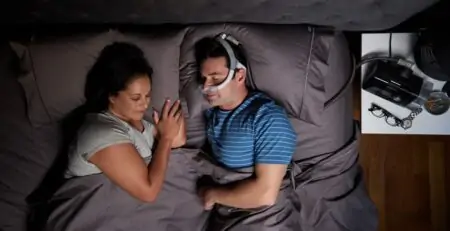Exercises to strengthen breathing and reduce sleep apnea
Sleep apnea is a respiratory disorder that interrupts breathing during rest, affecting sleep quality and general health. Although there are treatments such as CPAP and lifestyle changes, strengthening the respiratory muscles through specific exercises can be an effective complementary strategy. Practicing these exercises helps to improve the muscle tone of the throat and tongue, reducing airway collapse and improving sleep quality.
The importance of strengthening the respiratory muscles
Muscle tone in the throat and airways plays a key role in the onset of sleep apnea. During sleep, the muscles relax, which can lead to airflow obstruction. By strengthening these muscles, airway collapse can be minimized and the frequency and intensity of apnea episodes can be reduced. In addition, better breathing contributes to more efficient oxygenation of the body, promoting a deeper and more restful sleep.
Orofacial and tongue exercises
Orofacial and tongue exercises focus on strengthening the muscles of the mouth, tongue and throat. These exercises can help improve the stability of the upper airways, preventing them from collapsing during sleep. Consistent repetition of these exercises can lead to positive changes in muscle tone, allowing for smoother, uninterrupted breathing.
Some effective exercises include the controlled movement of the tongue towards the roof of the mouth, keeping the tongue pressed against the upper front teeth and making sucking movements. In addition, prolonged singing and the pronunciation of vowel sounds can help strengthen the muscles involved in breathing.
Deep and diaphragmatic breathing techniques
Deep diaphragmatic breathing is a technique that optimizes the use of the diaphragm, the main respiratory muscle. This type of breathing promotes more efficient inhalation and exhalation, reducing resistance to airflow in the airways. Consistent practice of this technique helps to increase lung capacity and improve sleep quality.
To practice diaphragmatic breathing, it’s important to adopt a comfortable posture, place one hand on your chest and the other on your abdomen and make sure that your breathing comes from your diaphragm and not your chest. Inhaling deeply through the nose and exhaling slowly through the mouth helps to strengthen the respiratory muscles and reduce sleep apnea.
Benefits of myofunctional training
Myofunctional training is a set of exercises designed to strengthen the muscles of the tongue, lips and throat. Its aim is to improve muscle tone to prevent airway obstruction during sleep. These exercises are especially useful for people with mild to moderate obstructive sleep apnea and can complement other treatments.
Regular practice of these exercises can significantly reduce the intensity of snoring and improve the quality of night-time breathing. Recommended myofunctional exercises include repeatedly lifting the tongue, over-pronouncing consonant sounds and chewing hard food to strengthen the oropharyngeal muscles.
Integrate exercise into your daily routine
To optimize the benefits, it is advisable to regularly perform breathing and muscle-strengthening exercises. Integrating them into your daily routine, dedicating a few minutes to them in the morning and evening, can gradually improve the quality of your sleep. In addition, its combination with other healthy practices, such as physical activity, a balanced diet and good weight control, will reinforce its positive effects on sleep apnea.
It’s important to remember that consistency is key to achieving visible results. Exercise is not a substitute for recommended medical treatment, but it can be a valuable complement to improving breathing and reducing the symptoms of sleep apnea.
Conclusion
Strengthening the respiratory muscles through specific exercises can be an effective strategy for reducing sleep apnea and improving sleep quality. The practice of orofacial exercises, diaphragmatic breathing and myofunctional training helps to optimize airway function by reducing resistance to airflow. Incorporating these exercises into the daily routine, along with a healthy lifestyle and appropriate medical treatments, can make a significant difference to sleep quality and overall well-being.
Terapiacpap
Latest posts by Terapiacpap (see all)
- Sleep apnea for the newly diagnosed: everything you need to know - 5 de March de 2025
- Restless legs syndrome, what is it and how to treat it? - 28 de February de 2025
- Consequences of not treating sleep apnea: health risks - 21 de February de 2025
- Exercises to strengthen breathing and reduce sleep apnea - 14 de February de 2025
- Tips for renewing your pillow and sleeping better, not just any pillow will do! - 28 de January de 2025













